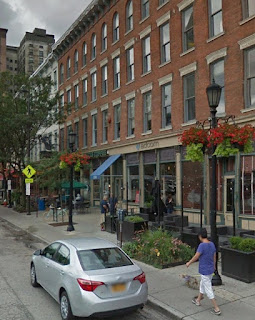City Block, although sought by the heavy-hitting, civic-minded BlockLand initiative to give blockchain technology a home base in the USA, will unite all sorts of technology start-ups in a collaborative setting. After investigating a dozen Cleveland sites, BlockLand's Place Committee has zeroed in on The Avenue at Tower City Center, according to several sources who asked not to be identified. The reason is that negotiations haven't yet concluded, so it's not yet a done deal.
** UPDATE: Blockland founder Bernie Moreno and Cuyahoga County Executive Armond Budish both confirmed on April 19 that Tower City would be the site for City Block but were unable to discuss details as yet. **
The Avenue is the mostly retail space at Tower City topped by skylights which were originally built as the railroad and rapid transit stations of Cleveland Union Terminal in 1930 and converted to their current uses in 1991 by Forest City Enterprises.
search criteria. The Place Committee prefers an existing building, one that is located in downtown Cleveland, and offers about 300,000 square feet of collaborative space. The Tower City complex surrounding The Avenue has under one roof nearly 2 million square feet of existing office space, 300 housing units, two hotels, and five rail transit lines fanning outward including to the airport.
Underutilized, The Avenue itself offers 366,000 square feet of space for retailers, cafes, restaurants and even offices. About half of The Avenue is vacant and more tenants will leave soon to make way for renovations. Some retailers will stay.
One of The Avenue's largest tenants is the City of Cleveland's Office of Sustainability. It has its Sustainable Cleveland Center in a former J.Crew store on two levels above the food court and below the Ritz Carlton Hotel. It plans to move out by July at the urging of Mayor Frank Jackson's administration, a City Hall source said.
Funding would come mostly from investors and foundations. A new $50 million partnership was announced between NCT Ventures of Columbus and the Cleveland Foundation to help boost the city's technology scene. It is not clear how much of this funding could be used directly for developing City Block, however.
"We're hoping to bring companies here who want to access U.S. markets and need a U.S. headquarters," said BlockLand leader Bernie Moreno in Crain's Cleveland Business. "I'm seeing Cleveland as a spot for that."
In that same article, Moreno said he wants to bring to City Block one or more Fortune 100 regional offices, or a nascent blockchain-brand being developed by a Fortune 100 tech firm. Here are the Fortune 100 tech firms, with one or more of these being approached by Moreno:
4 Apple
8 Amazon
9 AT&T
16 Verizon
22 Alphabet (aka Google)
30 Microsoft
33 Comcast
34 IBM
35 Dell Technologies
46 Intel
51 United Technologies (recently was broken up & bought out)
58 HP
74 Charter Communications (aka Spectrum)
76 Facebook
82 Oracle
83 Tech Data
98 Time Warner
The Avenue was bought from Forest City by Bedrock LLC in 2016. Ever since then, Bedrock has had little or no interest in maintaining retail as the dominant use at the The Avenue. Going as far back as last August, Ken Till, vice president of development for the Detroit-based Bedrock's Cleveland properties, identified all of the components of City Block without anyone realizing he was letting the cat out of the bag.
"We're really looking at mixed-use development," Till said to WCPN's Aug. 9, 2018 The Downtower podcast. "That means office space, school space, maybe a tech incubator."
END

















